Cells are the basic building blocks of the tissues and organs of our body. Usually these cells divide to make new cells in a controlled manner and beyond a point the cells are replaced with new cells. This is how our bodies grow, heal and repair. Sometimes, this orderly growth of cells can go wrong due to the mutation or sudden change in the genes which control how cells behave. This can make the cells to divide abnormally producing more and more abnormal cells which then form a lump called as a tumour. These cells lack the ability to stay together, can easily detach from each other and spread via direct contact, lymphatics and blood stream to other organs in the body.
The breast consists of multiple lobules producing milk which are connected to the nipple by multiple ducts. Breast cancer arises commonly from the cells lining the ducts of the breast and is known as Ductal carcinoma. If the abnormal cells have not breached the basement membrane, it is called as Ductal Carcinoma in Situ. If the abnormal cells lining the ducts have breached the membrane and is able to spread to other areas of the breast it is then called as Invasive Ductal Carcinoma. Similarly the cells lining the lobules of the breast can become abnormal producing cancer and this is called Lobular Carcinoma. Depending on whether the abnormal cells have breached the basement membrane or not, they are called as Invasive Lobular Carcinoma and Lobular carcinoma in situ. Sometimes the cells lining the connective tissue of the breast can become abnormal and producing a tumour called as phyllodes tumour.
The most common symptom of breast cancer is a lump in the breast. Other symptoms and signs of breast cancer are changes in the size and shape of the breast, bloody nipple discharge, changes in the breast skin and nipple, lumps in the axilla and occasionally breast pain. Early breast cancers may not present with any symptoms and signs and maybe found by routine screening. To more about symptoms and signs of breast cancer please click here.
Breast cancer is diagnosed by Triple Assessment which means Assessment is done by the following components namely.
The Breast cancer spreads initially to the lymph nodes in the same side axilla by means of lymphatic system. Beyond that it can spread by bloodstream to the liver, lungs, brain and bones.
The grade of breast cancer describes how abnormal the tumour cells look under the microscope compared to normal tissue. It indicates how quick a tumour tissue is likely to grow and spread. In breast cancer the pathologist looks at the biopsy specimen and classifies the tissues as low grade or well differentiated tumour, intermediate grade or moderately differentiated tumour and high grade or poorly differentiated tumour. High grade tumours may spread fast and may need more aggressive treatment.
Staging of Breast Cancer helps us to know the severity of the breast cancer based on how far it has spread. Staging is done based on the size of tumour, presence of enlarged lymph nodes and spread beyond lymph nodes to other parts of the body. This helps us to decide the treatment to be offered to the patient. In addition, it also helps us to know about the prognosis of the patient. Breast cancer is divided into 4 stages with Stage 1 &2 known as Early Breast Cancer (To know more Early Breast Cancer click here), Stage 3 known as Locally Advanced Breast Cancer (To know more about Locally Advanced Breast Cancer click here) and Stage 4 is known as Metastatic Cancer.
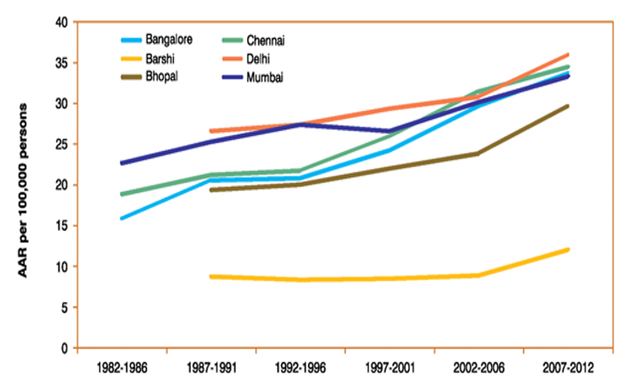
Breast cancer is the most common cancer among women in India and the incidence of breast cancer is increasing.
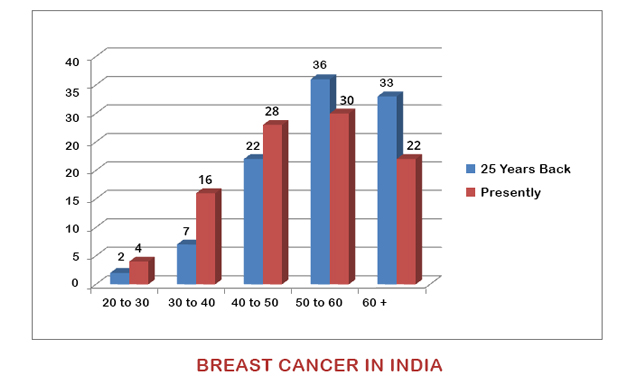
Breast cancer accounts for about one third of cancers among women. The incidence of breast cancer among young women seems to be on the rise compared to women 25 years back.
With modern methods of treatment the survival rate among women with breast cancers has increased to a 10 year survival rate of 83% . By regular screening methods we can detect breast cancers much earlier and improve the survival rate further.
Breast cancer is susceptible to various modalities of treatment. This
is
good because the various methods can be used together to give a good result.The main aim
of
surgery is to remove the cancer tissue in the breast as well as the lymph nodes in the
axilla. After removal of the tumour tissue by surgery, there can be some tumour cells
which
might have spread beyond the lump. These cells which have spread beyond the tumour are
taken
care of and killed by radiotherapy for cancer cells present locally near the breast and
by
chemotherapy and endocrine therapy for cancer cells that have spread beyond the breast.
The various methods to treat breast cancer are
The surgical modalities for breast cancer can be divided into those procedures which remove the cancer tissue from the breast and those surgical modalities which remove the lymph nodes in the axilla. We would need to choose one procedure from each modality. The procedure that is chosen for each patient will depend on the size of the tumour, stage of the tumour, size of the breast, presence of multiple lesions and patient preference.The various surgical procedures to remove the cancer tissue from the breast are.
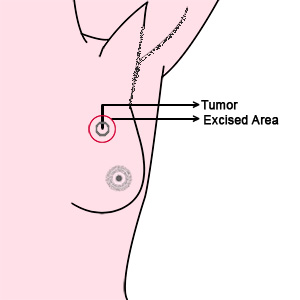
This can be done only for a small tumour in a large breast wherein we remove the breast cancer along with a small margin of tissue. If there are multiple lesions in the breast this procedure can not be done.The patient would definitely need radiotherapy after this procedure. By doing this we can conserve the breasts.(To know more about Breast Conservative Therapy please click here)
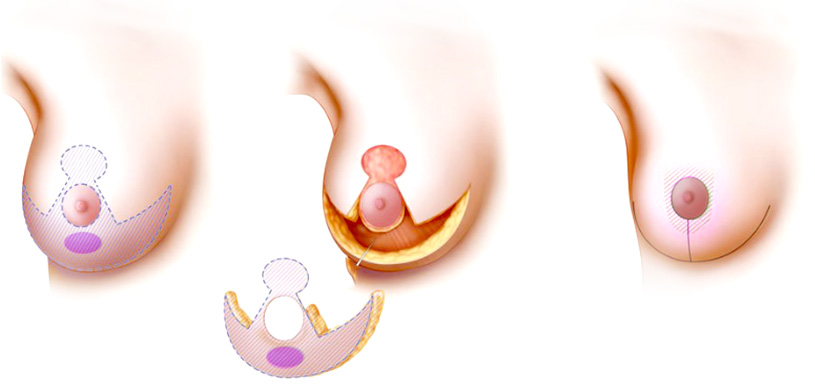
This procedure is done for slightly larger tumours in a large breast where in we remove a part of the breast and use breast reduction plastic surgical techniques to reduce the size of the breast. This breast would definitely need radiotherapy after the procedure.(To know more about Therapeutic Mammaplasty please click here)
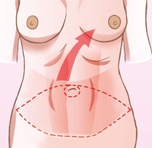
Here the whole breast is removed. This is done for small breasts, multiple tumours in the breast and breast cancers which present in an advanced stage. We offer the full gamut of reconstruction possibilities for the patient. The best method of reconstruction would be autologous reconstruction where we take the patients own tissues such as the tummy, inner thighs, back or buttocks to make a new breast. Reconstruction of the breast is best done at the same time of the mastectomy or removal of the breast as the patient wakes up with a new breast, surgery is done in one operation and the cosmetic result of a breast done at the same time of removal of the breast is better than when reconstructed at a later date.
Here the whole breast is removed. Some women may not want any form of
reconstruction
of the breast and would like to remain flat chested. They can use prosthesis in
their bras if necessary or they can get their breasts reconstructed after some
time.
Surgical procedures to address the lymph nodes in the axilla
The first place that breast cancer tends to spread is the lymph nodes in the axilla or the armpit. The procedures done to address the spread to the axilla are

Sentinel lymph node is the first lymph node that drains the breast cancer. It is assumed that if this lymph node is biopsied and no tumour is found then more radical procedures such a axillary lymph node dissection can be avoided. However if tumour is found in the lymph node biopsied, a complete axillary lymph node dissection needs to be done. (To know more about sentinel lymph node biopsy click here)
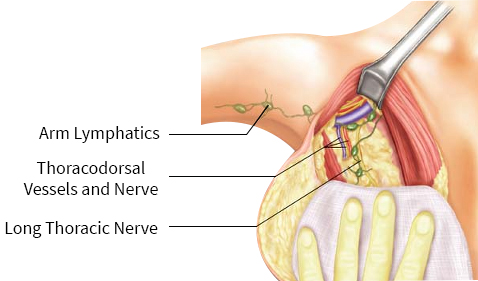
Axillary lymph node dissection is done when there is a lymph node which is palpable in the axilla or if sentinel lymph node biopsy is positive. Here the entire group of lymphatics in the axilla is removed. (To know more about axillary dissection please click here)
When patients present with Stage III Breast Cancer in an advanced stage, chemotherapy is given initially to downsize the tumour followed by surgery so that there is less chance of recurrence.
Using an intravenous line, chemotherapy drugs are injected. As the drugs go to all parts of the body it helps to kill the cancer cells which have spread to any other part of the body. In certain tumours as in Stage III tumours it is used as Neoadjuvant Chemotherapy to decrease the size of the tumour. It is also given after surgery or when it has spread to different parts of the body. The regimen and drugs given can vary between different individuals based on the cancer, the stage of presentation and the ability of the individual to tolerate the drugs.
Radiotherapy is given to prevent recurrence of the breast cancer in the local area. It is given if the tumour is big or if the lymph nodes in the breast are involved or when procedures like Breast Conservative Therapy and Therapeutic Mammaplasty are done.
Some cancer tissues have receptors for hormones. When hormones attach to such tissues, the cancer cells tend to grow. So some medicines can be given so that the hormones do not attach to the cancer tissue and prevents it from growing. This hormonal therapy is usually given after the other modalities such as surgery, chemotherapy and radiotherapy are given. Usually these medications are given for 5 to 10 years.
We at Ganga Hospital will be happy to answer any doubts that you may have regarding treatment for breast cancer, breast reconstruction or for cosmetic surgery for the breast. Please enter your mobile number and your email ID so that we can reply back to you. You can scan and attach your reports or photos which would enable us to make a decision. Alternatively you can whats app your doubts to the Ganga Breast Care Unit number +91 9952617171. The corresponding doctor would respond to you within 24 hours

